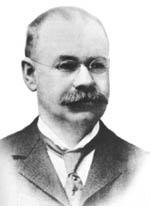Hermann Hollerith
Inventor, b. 29 February 1860 (Buffalo, New York, USA), d. 17 November 1929 (Washington, DC.).
 Hermann Hollerith's father had been involved in the German revolution of 1848 and had to flee to America, where Hermann was born. Hermann entered the School of Mines of Columbia University at the age of 15 and graduated at 19 in 1879. He became the assistant of one of his professors, who was involved in the preparation of the national census for 1880.
Hermann Hollerith's father had been involved in the German revolution of 1848 and had to flee to America, where Hermann was born. Hermann entered the School of Mines of Columbia University at the age of 15 and graduated at 19 in 1879. He became the assistant of one of his professors, who was involved in the preparation of the national census for 1880.
At the Census Office John Shaw Billings, who was responsible for essential statistics, described to Hollerith how it should be possible to encode the information for every person on a card by means of notches punched into the edge of the card. For the next ten years, wherever he was employed, Hollerith worked on this idea.
In 1882 Hollerith was appointed lecturer at the Massachusetts Institute of Technology (MIT) in Boston. He left within a year to join the U.S. Patent Office but soon set himself up as an "Expert and Solicitor of Patents." During that time he built some parts of a calculating device and took them to the Census Office for a demonstration. The response was positive, so Hollerith took out a patent for "certain new and useful improvements in the Art of Compiling Statistics" in 1884. Three years later he took out a patent for a punch card calculator.
In an effort to prove his concept of Hollerith offered his services to the health department of Baltimore. He punched thousands of cards himself, more than one thousand per day. The demonstration worked, and the state of New Jersey and the city of New York asked for his services. In 1888 he had his first federal contract, with the surgeon general's office of the War Department.
By the time of the 1890 census Hollerith had invented machines that read and sorted punched cards electrically. After demonstrating his system as superior to two rival systems he was given the contract for the census. In 1896 he established the Tabulating Machine Company, which received the contract for the 1900 census and was successful in Europe as well.
Argument about the price for Hollerith's services arose before the 1910 census, and the contract was given to a rival company that tried to modify Hollerith's machines to get around patent infringement. The Tabulating Machine Company won the lawsuit but too late for the contract. In 1911 the company was sold, making Hollerith a retired millionaire, and combined with three other office machine companies into the Computing-Tabulating-Recording Company (CTR). In 1924 CTR changed its name to International Business Machines (IBM).
Reference
Shurkin, J. (1984) Engines of the Mind. W. W. Norton & Company, New York.
home
 Hermann Hollerith's father had been involved in the German revolution of 1848 and had to flee to America, where Hermann was born. Hermann entered the School of Mines of Columbia University at the age of 15 and graduated at 19 in 1879. He became the assistant of one of his professors, who was involved in the preparation of the national census for 1880.
Hermann Hollerith's father had been involved in the German revolution of 1848 and had to flee to America, where Hermann was born. Hermann entered the School of Mines of Columbia University at the age of 15 and graduated at 19 in 1879. He became the assistant of one of his professors, who was involved in the preparation of the national census for 1880.